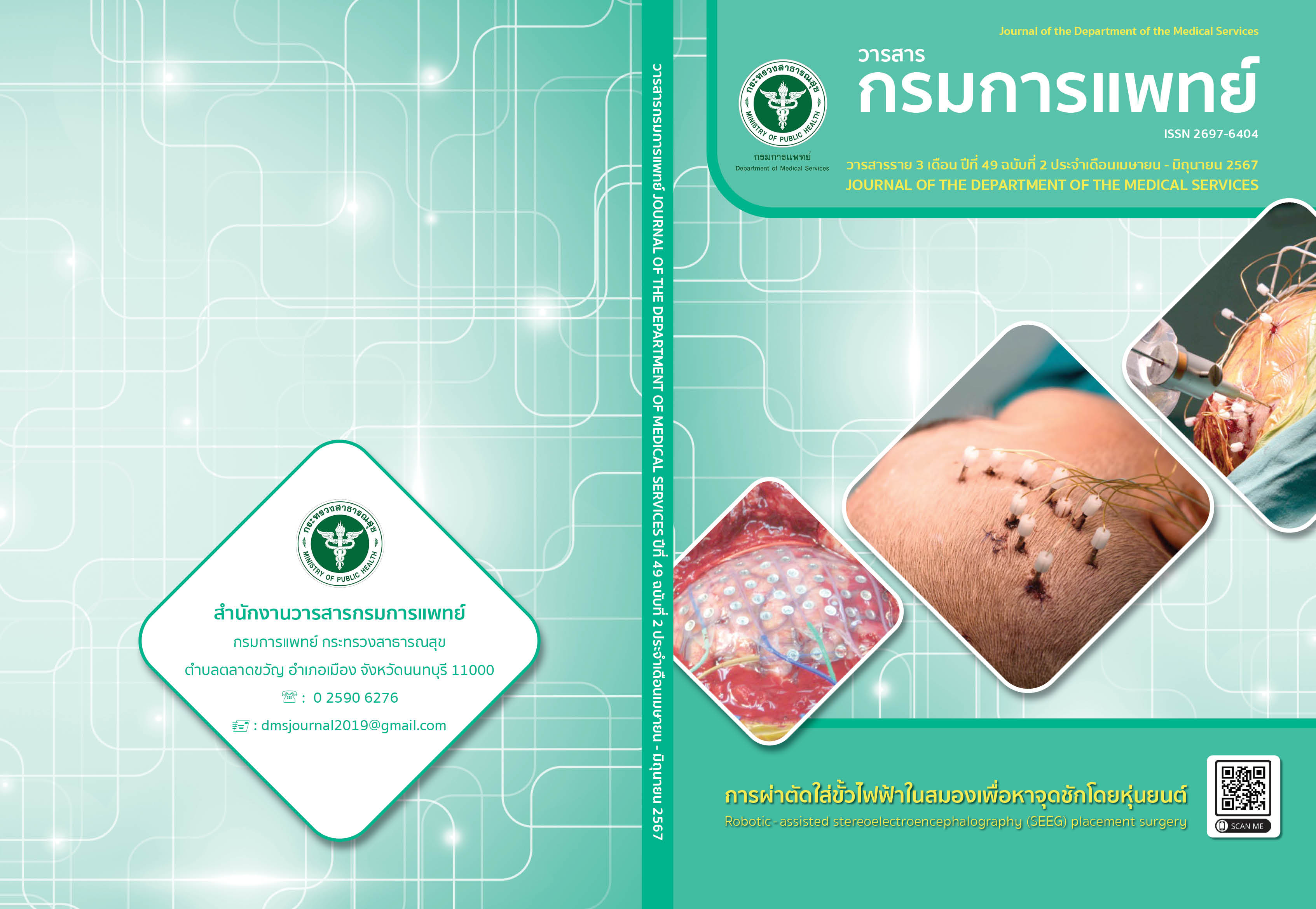Nasal Obstruction Symptom Evaluation Questionnaire: Cross Cultural Adaptation, Validity and Reliability of the Thai Version
Keywords:
NOSE score, Quality of life, Nasal obstruction, VAS score, PNIFAbstract
Background: Nasal obstruction is the most common rhinologic complaint that affects quality of life. There was no available fast and easy - to - use questionnaire related to nasal obstruction symptoms in Thai language. Objective: To translating and cross - culturally adapting the nasal obstruction symptom evaluation score into Thai (T - NOSE score) and to assess the validity, reliability of the translated version. Method: A cross - sectional study was conducted in adult patients with nasal obstruction in otolaryngology department at Rajavithi hospital from October 2020 - July 2021. The Beaton protocol for cross - cultural adaptation was used in the translation process. Five otorhinolaryngologists were asked to assess content validity while 30 participants were asked to fll in the questionnaire to assess Cronbach’s for internal consistency. Pearson correlation coefficient was used between T - NOSE score, visual analog score (VAS score) and peak nasal inspiratory (PNIF). Receiver operating characteristic (ROC) was applied to calculate area under the curve for cut point, sensitivity, and specificity for screening nasal obstruction. Result: The T - NOSE score had good content validity (IOC = 0.96). The Cronbach’s
was 0.872 which is satisfactory indicating good internal consistency. 100 adult patients (41 males and 59 females) were recruited to assess correlation. Pearson correlation between T - NOSE score and VAS showed a strong correlation (r = 0.849). Simultaneously, T - NOSE score showed moderately reverse correlation with PNIF (r = –0.576) with statistically significant. The appreciate cut off point of T - NOSE score for screening was 32.5 with a sensitivity of 76.9 %, 64.6% specificity, 70.2% PPV and 72.1% NPV to predict nasal obstruction status. Conclusion: Thai NOSE score is a valid and reliable questionnaire which can be used for screening nasal obstruction symptom in adult Thai population.
References
Kimmelman CP. The problem of nasal obstruction. Otolaryngol Clin North Am 1989;22(2):253-64
Flint PW. Cummings Otolaryngology : Head and Neck Surgery. 7th ed. Philadelphia, PA: Elsevier; 2021.
Chandra RK, Patadia MO, Raviv J. Diagnosis of nasal airway obstruction. Otolaryngol Clin North Am 2009;42(2):207-25, vii.
Thanasumpun T, Assanasen P. Nasal obstruction. Thai J Otolaryngol Head Neck Surg 2018;2-18.
Stewart MG, Witsell DL, Smith TL, Weaver EM, Yueh B, Hannley MT. Development and validation of the Nasal Obstruction Symptom Evaluation (NOSE) scale. Otolaryngol Head Neck Surg 2004;130(2):157-63.
Tantilipikorn P, Meekul N, Suwanwech T, Assanasen P. Peak nasal inspiratory flow: reference values for Thais. Siriraj Med J. 2015 67(6):267-72.
Rujanavej V, Snidvongs K, Chusakul S, Aeumjaturapat S. The validity of peak nasal inspiratory flow as a screening tool for nasal obstruction J Med Assoc Thai 2012;95(9):1205-10.
Beaton DE, Bombardier C, Guillemin F, Ferraz MB. Guidelines for the process of cross - cultural adaptation of self - report measures. Spine (Phila Pa 1976) 2000;25(24):3186-91.
Terwee CB, Bot SD, de Boer MR, van der Windt DA, Knol DL, Dekker J, et al. Quality criteria were proposed for measurement properties of health status questionnaires. J Clin Epidemiol 2007;60(1):34-42.
Marro M, Mondina M, Stoll D, de Gabory L. French validation of the NOSE and RhinoQOL questionnaires in the management of nasal obstruction. Otolaryngol Head Neck Surg 2011;144(6):988-93.
Spiekermann C, Savvas E, Rudack C, Stenner M. Adaption and validation of the nasal obstruction symptom evaluation scale in German language (D - NOSE). Health Qual Life Outcomes 2018;16(1):172.
Lachanas VA, Tsiouvaka S, Tsea M, Hajiioannou JK, Skoulakis CE. Validation of the Nasal Obstruction Symptom Evaluation (NOSE) Scale for Greek Patients. Otolaryngol Head Neck Surg 2014;151(5):819-23.
Zijl FVWJ, Timman R, Datema FR. Adaptation and validation of the Dutch version of the nasal obstruction symptom evaluation (NOSE) scale. Eur Arch Otorhinolaryngol 2017;274(6):2469-76.
Karahatay S, Taşli H, Karakoç Ö, Aydin Ü, Türker T. Reliability and validity of Turkish Nose Obstruction Symptom Evaluation (NOSE) scale. Turk J Med Sci 2018;48(2):212-6.
Dąbrowska - Bień J, Skarżyński H, Gos E, Gwizdalska I, Lazecka KB, Skarżyński PH. Clinical evaluation of a polish translation and cross - cultural adaptation of the nasal obstruction symptom evaluation (NOSE) scale. Med Sci Monit 2018;24:7958-64.
Larrosa F, Roura J, Dura MJ, Guirao M, Alberti A, Alobid I. Adaptation and validation of the Spanish version of the Nasal Obstruction Symptom Evaluation (NOSE) Scale. Rhinology 2015;53(2):176-80.
Mozzanica F, Urbani E, Atac M, Scottà G, Luciano K, Bulgheroni C, et al. Reliability and validity of the Italian nose obstruction symptom evaluation (I - NOSE) scale. Eur Arch Otorhinolaryngol 2013;270(12):3087-94.
Tsounis M, Swart KM, Georgalas C, Markou K, Menger DJ. The clinical value of peak nasal inspiratory flow, peak oral inspiratory flow, and the nasal patency index. Laryngoscope 2014;124(12):2665-9
Lipan MJ, Most SP. Development of a severity classification system for subjective nasal obstruction. JAMA Facial Plast Surg 2013;15(5):358-61.
Sokal RR, Rohlf FJ. Introduction to biostatistics. Mineola (N.Y.): Dover Publications; 2009.
Downloads
Published
How to Cite
Issue
Section
License
Copyright (c) 2024 Department of Medical Services, Ministry of Public Health

This work is licensed under a Creative Commons Attribution-NonCommercial-NoDerivatives 4.0 International License.
บทความที่ได้รับการตีพิมพ์เป็นลิขสิทธิ์ของกรมการแพทย์ กระทรวงสาธารณสุข
ข้อความและข้อคิดเห็นต่างๆ เป็นของผู้เขียนบทความ ไม่ใช่ความเห็นของกองบรรณาธิการหรือของวารสารกรมการแพทย์



